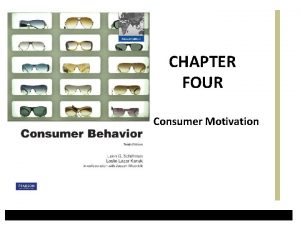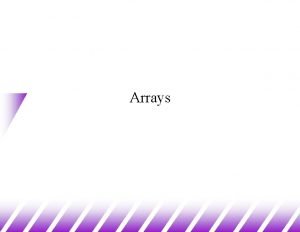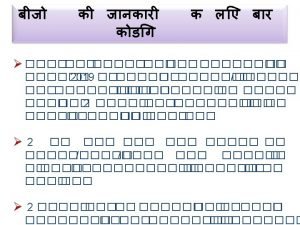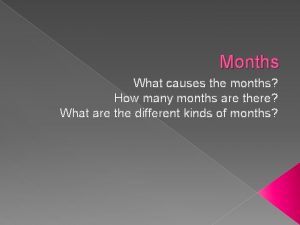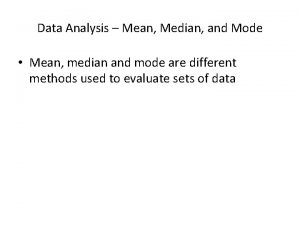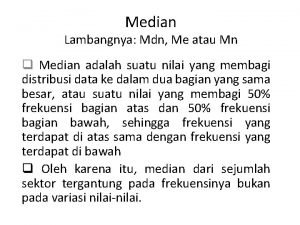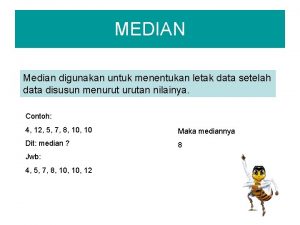Results After a median 32 months of followup
















- Slides: 16











• Results After a median 32 months of follow-up, there was no significant difference in the occurrence of the primary endpoint – a composite of cardiovascular death, nonfatal myocardial infarction, nonfatal stroke, or unstable angina with urgent revascularization – between the 3098 patients receiving febuxostat and the 3092 patients in the allopurinol group, at rates of 10. 8% and 10. 4%, respectively. However, patients receiving febuxostat were a significant 22% more likely to die from any cause than those taking allopurinol, with rates of 7. 8% versus 6. 4%, and this was due to “an imbalance in cardiovascular deaths” between the two groups, report the researchers. Indeed, the rate of cardiovascular death was 4. 3% in the febuxostat group and 3. 2% in the allopurinol group, translating into a significant 34% increased risk with febuxostat. The CARES (Cardiovascular Safety of Febuxostat and Allopurinol in Patients with Gout and Cardiovascular Morbidities) trial was “conducted as an FDA requirement” to establish whether febuxostat is noninferior to allopurinol in relation to cardiovascular safety following the results of placebo-controlled trials suggesting a “modestly higher rate” of cardiovascular events with febuxostat, explain White and colleagues. They note that the mechanisms underlying the increased risk for death among febuxostattreated patients are “unclear, ” given that adjudicated rates of nonfatal cardiovascular events were comparable between the groups, and preclinical studies of febuxostat demonstrated no toxic cardiovascular effects related to heart rhythm and function.

Ma leggiamo i dati: Studio Cares Dopo un follow-up medio di 32 mesi non si e’ trovata una significativa differenza del rischio con un endpoint primario composto da: morte cardiovascolare, morte, infarto miocardico, ictus , angina instabile, e angina instabile con rivascolarizazzione – tra i 3098 pazienti in febuxostat e i 3092 patienti allocati al gruppo allopurinolo, con valori rispettivamente 10. 8% and 10. 4%. Tuttavia i pazienti in che ricevevano febuxostat hanno presentato un significativo aumento del rischio di morte del 22%, dovuto a un “imbalance in cardiovascular deaths” nei due gruppi, come riportato nel lavoro. La mortalita’ cardiovasculare e’ stata 4. 3% nel Gruppo febuxostat e 3. 2% nel Gruppo allopurinolo, con un 34% di aumento nel Gruppo in febuxostat.



Circulation • Iperuricemia e gotta sono associate con un aumento di rischio cardiovascolare. Gli inibitori delle Xanthine oxidase, allopurinol e febuxostat, rappresentano il trattmento piu’ usato per la gotta e possono avere differenti effetti nei pazienti con gotta. • . METODI: usando i dati di Medicare (2008– 2013), questi autori hanno condotto uno studio di cohorte per valutare la cardiovascular safety dell’inziare febuxostar versus allopurinolo in pazienti in con gotta e ≥ 65 anni. L’obbiettivo primario era una combinazione di eventi primari e secondari. Risultati: gli autori hanno studiato 24 936 soggetti che usavano il febuxostat vs 74 808 pazienti in allopurinolo. • L’eta’ media era 76 anni , 52% maschi, 12% avevano patopogie cardiache. Il rischio di eventi avversi , incluso quello di mortalita’ era simile nei due gruppii, ma c’ear una modesta riduzione di rischio per scompenso cardiaco (hazard ratio, 0. 94; 95% CI, 0. 91– 0. 99) in febuxostat initiators. • In questo studio Il rischio associato all’uso del febuxostat a tre anni e’ stato del 1. 25 (95% CI, 0. 56– 2. 80) versus allopurinolo • Subgroup and sensitivity analyses consistently showed similar cardiovascular risk in both groups. • CONCLUSIONIS: Among a cohort of 99 744 older Medicare patients with gout, overall there was no difference in the risk of myocardial infarction, stroke, new-onset heart failure, coronary revascularization, or all-cause mortality between patients initiating febuxostat compared with allopurinol. However, there seemed to be a trend toward an increased, albeit not statistically significant, risk for all-cause mortality in patients who used febuxostat for >3 years versus allopurinol for >3 years. The risk of heart failure exacerbation was slightly lower in febuxostat initiators.

• EDITORIAL Gout, Xanthine Oxidase Inhibition, and Cardiovascular Outcomes • Article, see p 1116 Gout, a chronic rheumatologic illness characterized by hyperuricemia, arthritis, tophaceous deposits, and renal calculi, is associated with increased rates of cardiovascular and chronic kidney disease. 1 Prospective observational studies have shown that the risk of cardiovascular mortality is higher in people with gout and coronary heart disease compared with those with coronary disease who do not have gout. 2 Epidemiological associations among hyperuricemia, gout, and risk factors for cardiovascular disease are robust, 3 but whether hyperuricemia and gout are independent risk factors for coronary disease remains controversial. Urate has a complex relationship to oxidative stress, possessing both scavenging properties as well as oxidizing and radical-forming properties. 4, 5 These data have led to small, interventional studies that have shown that urate-lowering agents such as allopurinol may improve a number of cardiovascular conditions, including heart failure, 6 hypertension, 7 and chronic kidney disease. 8 The xanthine oxidase inhibitors are the mainstay of therapy for reducing serum urate levels in patients with gout. The xanthine oxidase inhibitor allopurinol was approved in 1966, and febuxostat, a nonpurine inhibitor of xanthine oxidase, was approved for the management of hyperuricemia in patients with gout in 2009. Allopurinol and its metabolites are structural analogues of both purines and pyrimidine compounds and thus can affect enzymes in both metabolic pathways, whereas febuxostat is a nonpurine inhibitor of only xanthine oxidase. 9 In clinical practice, the pharmacological advantages of febuxostat over the commonly used doses of allopurinol have included greater serum urate-lowering efficacy, fewer reported severe hypersensitivity reactions, and no requirement for dose adjustment in patients with moderate renal impairment, a common comorbidity in gout. 1, 9 During the development of febuxostat, this drug was compared to placebo and allopurinol in clinical trials involving >5000 patients with gout. 9, 10 These studies showed a small imbalance in the rates of major cardiovascular events occurring at 0. 74 per 100 patient-years with febuxostat versus 0. 60 per 100 patient-years with allopurinol. The US Food and Drug Administration approved febuxostat with the contingency that a large cardiovascular safety outcome study be performed to determine its cardiovascular profile compared to allopurinol in patients with gout. This study, the CARES trial (Cardiovascular Safety of Febuxostat and Allopurinol in Patients With Gout and Cardiovascular Morbidities), was conducted between 2010 and 2017 to determine whether febuxostat was noninferior to allopurinol on major cardiovascular events in patients with gout and cardiovascular disease. 11 The study population for the CARES trial was limited to patients with gout who had prior evidence of cardiovascular disease, a strategy previously used in the US Food and Drug Administration-mandated cardiovascular safety studies in diabetes • © 2018 American Heart Association, Inc. • https: //www. ahajournals. org/journal/circ • Circulation
 Followup edge
Followup edge Followup:actionitems
Followup:actionitems Follow up visit
Follow up visit John 14 1
John 14 1 After me after me after me
After me after me after me 3 median regression line
3 median regression line Promixmal
Promixmal Motivation process
Motivation process Pews chart 0-11 months
Pews chart 0-11 months Piagetian and information processing theories 8-18 months
Piagetian and information processing theories 8-18 months What are the islamic calendar months
What are the islamic calendar months French 12 months
French 12 months My friend will take me home after school in asl
My friend will take me home after school in asl Summer winter rainy spring autumn
Summer winter rainy spring autumn Define months
Define months During the summer months the monastery very busy
During the summer months the monastery very busy How many months is 141 days
How many months is 141 days







